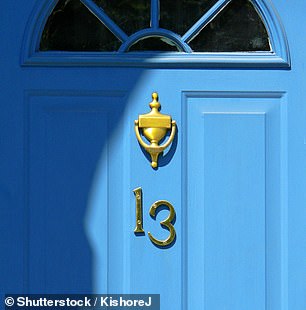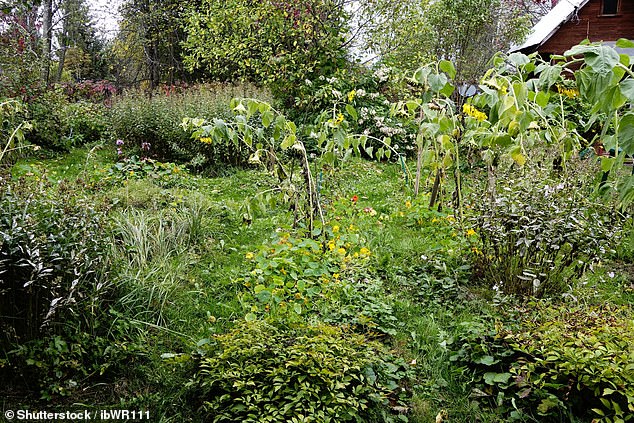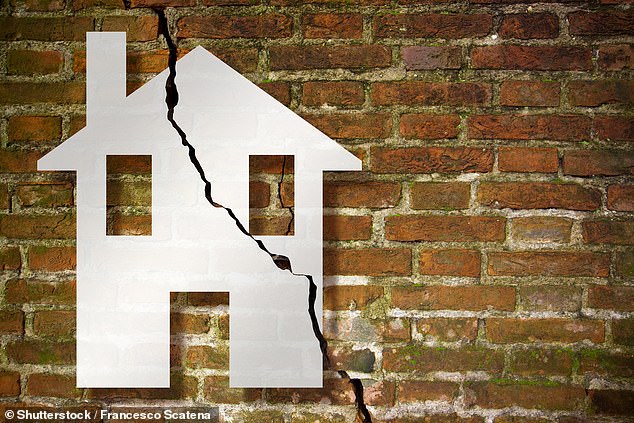Every seller likes to believe their home is perfect and is often blind to imperfections so obvious to potential buyers.
But features from your house number to certain plants in your garden could be a turn-off for viewers and wipe tens of thousands of pounds from your property’s price tag or put them off making an offer – especially in a slow housing market.
Fred Jones, chief executive at house-buying company Upstix, says: ‘It’s a buyers’ market.
There’s more supply than demand so, sometimes, when there are a lot of other options, these features might just prevent an offer.’
Online estate agency Yopa has compiled a list of the biggest property turn-offs and reveals how much each one will slash from an average property price.
Here are the top ten things that put buyers off – and what you can do to fix them before you put your property on the market.

Taking a plunge: A swimming pool that is rarely used or isn’t in tip-top condition can decrease your property’s value – by almost £53,000 on average
Unlucky house number – lose £16,099
You may think that the number of your house is only important because it tells the postman where to deliver your mail.
But a house number that is considered unlucky – 13, for example – could wipe £16,099 off the value of your home on average, as superstitious buyers avoid them.
Some new developments skip the number 13 and run from 12 to 14. In fact, the number of houses numbered 14 is double those numbered 13, says property portal Rightmove.

Superstition: A house number that is considered unlucky could wipe £16,099 off the value of your home
Unfortunately, you can’t typically change a house number due to personal preference. But you can add a name to your house.
Your house number must remain visible on the property – even if you’ve added a name.
To add a name, contact your local council to submit your choice – it can’t be similar to other house names in the area.
This will be added to the Land Registry once approved and then you can submit the name to the Royal Mail address maintenance unit.
Your local council could charge £25 to £50 for you to add a house name, according to the UK Sign Shop.
Unused or old swimming pool – lose £52,591
A swimming pool may add a touch of glamour to your home and can boost its price by up to 20 per cent when it’s properly maintained.
But one that is rarely used or isn’t in tip-top condition can decrease your property’s value – by almost £53,000 on average.
The cost of maintaining a pool may be a turn-off to buyers who will need to factor in around £650 annually for chemicals, up to £450 to fill it with water and as much as £250 for a professional monthly service.
New buyers could choose to get rid of it altogether but need to spend anywhere from £4,000 to £10,000 to remove it, depending on its size and type, according to trade platform MyJobQuote.
But taking action on a tired pool is probably better than leaving it as it is, as Niall Robinson, market specialist and valuer at London-based agency Paramount Properties, says the hassle of sorting it out is a major deterrent for buyers.
Japanese knotweed – lose £40,248
This herbaceous perennial rightly strikes fear among homeowners.
Japanese Knotweed was introduced to the UK in the 19th century as an ornamental garden plant but has proved both invasive and structurally damaging.
It requires a mammoth effort to get rid of and it can also slash more than £40,000 from your home’s price tag.
The presence of Japanese knotweed may mean a mortgage lender won’t lend on that property as it can cause structural issues – such as damaging walls and the foundations – and it also costs a lot to eradicate.

Invasive: A Japanese knotweed infestation requires a mammoth effort to get rid of and it can also slash more than £40,000 off the value of a property
Lenders can ask for a higher interest rate when mortgaging a property with knotweed, too. This will dramatically reduce your pool of potential buyers unless it’s sorted, which will in turn reduce the price.
For a large infestation, removal costs £5,000 for every ten square metres on top of £5,000 to £10,000 for extra expenses such as site set-up and surveying, according to environmental consultants PBA Solutions.
Treatment may include spraying it with chemicals, which typically takes at least three years to fully treat, burning it, or burying it.
Alan King, of estate agent Jackson Stops, says: ‘We had a case where a number of people viewed a property and didn’t want it even though the Japanese knotweed had been removed for a guarantee of ten years.
‘Be transparent – but remember Japanese knotweed will reduce the number of people interested.’
As a seller you can’t simply pretend it isn’t there so your property sells for a higher price – and even genuine ignorance of the problem could come back to bite you.
Jonathan Handford, managing director at estate agency Fine & Country, says one seller said he confirmed he did not have knotweed in his garden when filling out the conveyancing form.
Unfortunately, he was unaware the property did have knotweed and, after he sold it, the buyer pursued him for damages.
‘Say you don’t know if there is Japanese knotweed unless you’ve checked every square inch,’ he says.
Pylons/power line – lose £37,565
Living close to an eyesore pylon may become the reality for many more of us as the Labour Government is set to introduce swathes of new pylons and power lines in the coming years in a bid to make electricity cheaper.

Eyesore: Living near a pylon, mobile phone tower or wind turbine could wipe almost £38,000 from your property’s price tag
But living near a pylon, mobile phone tower or wind turbine could wipe almost £38,000 from your property’s price tag.
Mr Jones says: ‘Some people think they carry health concerns and noise issues – and they are unsightly to look at.’
Flood risk/water damage – lose £36,491
If your property is at risk of flooding it could swipe more than £36,000 from its value as buyers factor in potential damage to the property and higher insurance premiums when making their offers.
If your home has been flooded before, then your premiums may be hiked or an insurer could even decline to offer you cover, putting off potential buyers from making a strong offer.
Mr King says this feature is the most concerning as it’s very unpredictable.
‘Nothing can really be done about it. You can get flood mitigation features put in and this can work but it’s a big project and in certain cases it’s a lost cause.’
One inexpensive measure is to move electrical outlets higher on your walls, which can cost anywhere from £80 to £150 per socket, to minimise damage for yourself and future owners. If you can, spend a little more money to add new drainage systems to your grounds.
The outlay is likely to pay for itself if it means potential buyers are less deterred from putting in an offer.
Next door is amess – lose £29,515
It may seem unfair but the poor upkeep of your neighbour’s property – which you can’t control – can wipe almost £30,000 from your property’s price tag.
If their grass is overgrown, a mattress is strewn in the garden or there’s poor kerb appeal, then buyers may offer less for a property or demand could be reduced which could in turn lead to a price reduction.
Mr Jones says if there’s a poor neighbouring property, buyers will be asking if that’s a sign of anti-social behaviour.
He says: ‘First impressions matter. Buyers will wonder if this is going to be a nuisance – and if they have loud dogs or music. They’ll wonder if this is this going to keep the children up and if there will be legal disputes.’
Always directly speak to the neighbour politely as a first port of call. As soon as the local council gets involved with the dispute, you’ll need to declare this to potential buyers when selling.
Neighbour dispute – lose £26,832
Many homeowners may have disagreed with a neighbour about who is responsible to repair a broken fence or trim an overhanging tree.
But when this goes one step further and the couple next door become enemies, almost £27,000 can be wiped from your property value.
As Mr King says, if you’ve had a dispute with your neighbour, you must declare it when selling the house, which could raise alarm bells for both buyers and their solicitors.
Always try to address the issue with your neighbour civilly. If there’s no dispute but a disagreement instead, it’s up to the seller to declare this.
One silver lining is that bad relations with neighbours are typically rooted in the individuals involved, so the dispute could end when one of you moves, Mr King says.
Unruly garden – lose £22,000
It’s natural that an unloved garden would knock money off a property value – but the damage can be as much as some £22,000.
Mr Jones says: ‘If the garden is really overgrown it’s a sign of neglect and further home issues. It also means you can’t see if the wall in the garden is intact.

Overgrown: A messy, unloved garden could knock as much as £22,000 off the value of a property
‘It will make buyers think, “they probably won’t have fixed the leaky roof”. It’s not just the issue itself but an indication that something else might be there which will take time, effort and money to fix.’
Even a quick spruce and mowing the lawn before viewings could make all the difference.
‘Buying a home is such an emotional decision. Some people just struggle to have the vision.
‘It all comes down to the place you can imagine living your life, so this might affect demand and the price people are willing to pay,’ adds Mr Jones.
No parking spot – lose £18,246
Parking is so important to buyers that houses with no parking areas or shoddy parking spots can slash about £18,000 from your house price.
If your property has no private driveway, it’s not only annoying for potential buyers who may have to apply for council parking permits and battle neighbours for the last space, it can affect insurance premiums, too.
Car insurance payments can increase if the only option is on-street parking, as it could be damaged by another driver whizzing past or by vandals if your car isn’t kept inside a garage.
Subsidence – lose £53,664
Subsidence is every homeowner’s worst nightmare. As the ground beneath your property sinks, it pulls the foundations of your home with it, causing large cracks to appear on the walls.
It slashes an average of £54,000 from your home’s value in the process – but the damage can cost as much as six figures in some situations.
Mr Handford says: ‘The features that have the most detrimental impact to a property value are anything that impacts the ability to get borrowing, such as subsidence.
‘It proves complicated to get a mortgage, so subsidence will affect value and saleability. Professionals have a duty of care to a buyer.’

High risk: Subsidence is caused when the ground beneath your property sinks, it pulls the foundations of your home with it, causing large cracks to appear on the walls
Lenders view properties with subsidence as a huge lending risk, as structural issues could mean the property later becomes uninhabitable.
Even a cash buyer may be warned against a purchase by surveyors, as it can impact their ability to sell the property in the future.
But banks may be more comfortable if it’s historic subsidence, which is where it has been fixed and has not recurred.
Lenders will hold the keys to a purchase going through, so it’s worth tackling subsidence before sale.
Treatment may include removing root causes such as trees, or repairing leaky pipes, both of which could cause the foundations and ground beneath your home to be unsupported.
Costs will depend on the treatment needed, but it can be from £6,000 to £14,000 on average, says consumer website Home Selling Expert.
Home insurance may cover this cost but only if your house hasn’t faced subsidence before. Yet even this isn’t enough to protect your property from having its value deplete.
Mr Robinson says even if subsidence has been treated it could still knock 2 per cent off the property value as buyers fear it returning.
‘Subsidence is something that can arise again. After treatment it’s probably a better building than the one next door, but it’s the way subsidence is viewed that can cause issues.’

